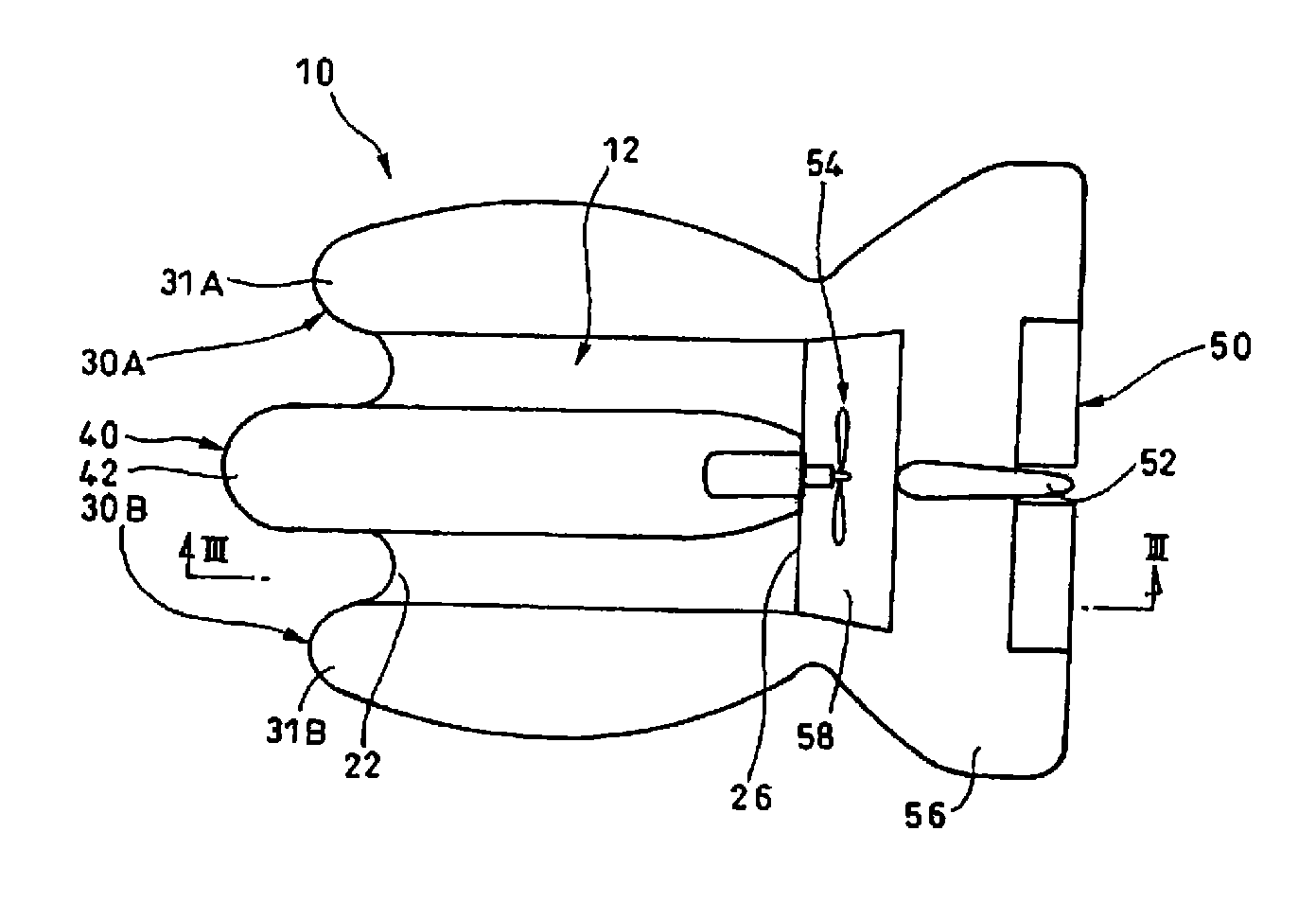Positive-pressure flying aircraft
a technology of positive pressure and flying aircraft, applied in the field of aircraft, can solve the problems of aircraft stalling, not being stabilized, and difficult for aircraft to run on the ground
- Summary
- Abstract
- Description
- Claims
- Application Information
AI Technical Summary
Benefits of technology
Problems solved by technology
Method used
Image
Examples
embodiment 1
[0042]In FIGS. 1 and 2, a positive-pressure-flying aircraft 10 in Embodiment 1 comprises a wing 12; a right-side body 30A; a left-side body 30B, a middle body 40; an elevator 50; a rudder 52; a propeller 54 at the rear end of the middle body 40; and a horizontal stabilizer 56 that extends horizontally.
[0043]An elevator 50 is mounted to the rear end of the horizontal stabilizer 56. In FIG. 3, the wing 12 has a rounded leading edge 22 and an acute trailing edge 26. The maximum thickness portion 21 is located at 2 / 10 to 3 / 10 of the chord length.
[0044]The thickness of the maximum thickness portion 21 of the wing 12 is 3 / 10 to 4 / 10, preferably 35 / 100, of the cord length.
[0045]The diameter of an arc of the leading edge 22 is defined as ⅓ of the thickness of the maximum thickness portion 21. For example, the leading edge 22A has a diameter that is equal to the maximum thickness D in FIG. 4, or D / 3. In FIG. 5, between a circle of the diameter D and a circle of the diameter D / 3, a circle of ...
embodiment 2
[0074]A positive-pressure flying aircraft 70 in Embodiment 2 of the present invention will be described in FIGS. 7 to 10.
[0075]The positive-pressure flying aircraft 70 is a whole-wing-type aircraft which has a wing 74 equal to the right and left bodies in Embodiment 1 in height. In an air trap 72, the sum of widths of right and left side walls 73 forming right and left guide surfaces 73A,73B is equal to the width of the wing 74. The air trap 72 is defined by the right and left guide surfaces 73A, 73B and a bottom surface 72A.
[0076]In the middle of the wing 74, a middle body 40 similar to that of Embodiment 1 is provided. The front end of the middle body 40 is positioned in front of the front end of the wing 74, and concaves 76 are formed in FIGS. 7 and 8. With the concaves 76, hemispherical leading edges 31A,31B having vertical cross sections identical with those of the right and left bodies 30A,30B in Embodiment 1 are formed.
[0077]With respect to other structure, the same numerals ...
PUM
 Login to View More
Login to View More Abstract
Description
Claims
Application Information
 Login to View More
Login to View More - R&D
- Intellectual Property
- Life Sciences
- Materials
- Tech Scout
- Unparalleled Data Quality
- Higher Quality Content
- 60% Fewer Hallucinations
Browse by: Latest US Patents, China's latest patents, Technical Efficacy Thesaurus, Application Domain, Technology Topic, Popular Technical Reports.
© 2025 PatSnap. All rights reserved.Legal|Privacy policy|Modern Slavery Act Transparency Statement|Sitemap|About US| Contact US: help@patsnap.com



